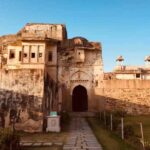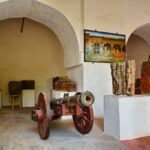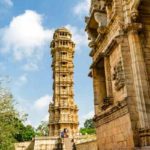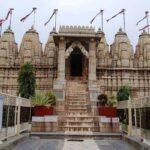Vijay Stambh Chittorgarh is a victory tower in the fort of Chittorgarh. It is located in the Chittor city of the state of Rajasthan in India. The Vijaya Stamba was constructed by the then king of Chittorgarh, Rana Kumbha. It was constructed to commemorate the victory against the joint forces of Malwa and Gujarat, led by Mahmud Khilji in 1448. The construction of the magnificent tower was started from 1458 and was completed by 1488. This tall massive tower can be viewed from any point of the city.
The Vijay Stambh Chittorgarh was constructed by dedicating it to Lord Vishnu. He was one of the presiding deities worshipped by the Rajputs. Carvings of various Gods and Goddesses on the Vijaya Stamba with intricate designs still can be observed. There are carvings of weapons, musical instruments and various tools used during that era that are found in the inner part of the tower. It is an example of religious pluralism practiced by the Rajputs. The word ‘Allah’ is carved many times in Arabic on different storied of the monument. The highest storey consists of the image of Jain Goddess Padmavati. This mighty tower is an archaeological gem which displays the rich history of India.
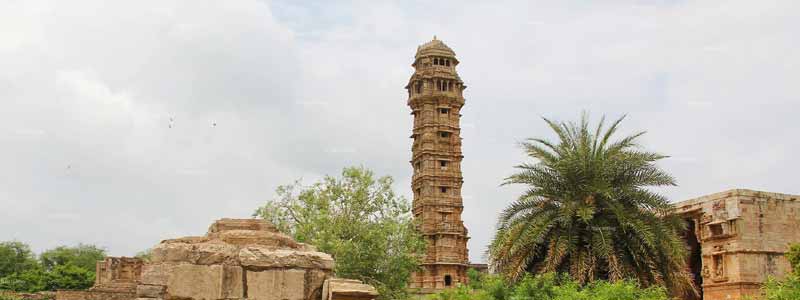
History of Vijay Stambh Chittorgarh
As you walk within the sprawling campus of the Chittor Fort, hundreds of stories from history tug at your heart. If the legendary devotion of Mirabai comes alive in one corner, the fearless pride of Padmini touches your very core in another corner. Standing tall as a silent sentinel, surveying the entire expanse of the fort is the Vijay Stambh – Tower Of Victory In Rajasthan.
The Vijaya Stambha at Chittorgarh Tourism is a celebration of a military victory by one of the famous kings of Mewar, Rana Kumbha. Rana Kumbha is known to have been a patron of arts and architecture and was the one who gave land for the building of the famous Ranakpur Jain Temple.
Rana Kumbha was constantly at war with the rulers of the Malwa Sultanate. His battles with Mahmud Khalji, the then Sultan of the Malwa Sultanate are legendary. One such battle is famous as the battle of Mandavgad or the battle of Sarangpur. One of the assassins of Rana Mokal Singh who was Rana Kumbha’s father was given sanctuary by Mahmud Khalji.
Rana Kumbha asked for the assassin to be handed over, but was refused by the Sultan. This led to a fierce battle in which the forces of the Sultan were defeated. Mahmud Khhalji faced the ignominy of defeat and was himself captured by Rana Kumbha and imprisoned, to be set free later.
Though there is no agreement among historians as to exactly when the Vijay Stambh Chittorgarh was built. It is estimated that the victory monument was built between 1458 to 1468, however, some historians opine that the fort was built in 1448.
Whatever may be the case, the truth is that the Vijay Stambha, Chittorgarh Tour Packages, was built in commemoration of the victory of Rana Kumbha over the combined forces of Mahmud Khalji and the Gujarat Sultanate.
Vijay Stambh Built By Rana Kumbha stands today as a proud reminder of the valour of the king and his patronage of art and architecture in Mewar.
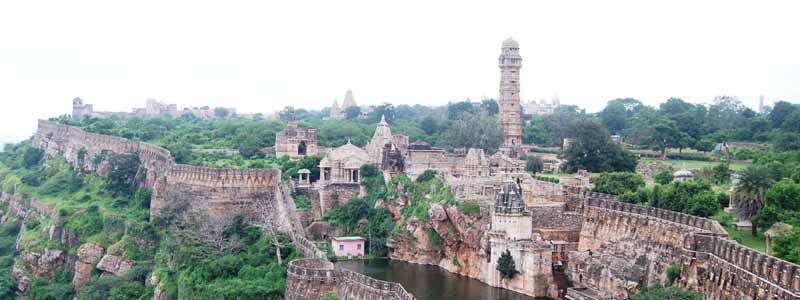
Vijay Stambh Architecture
The tower is adorned memorably with Hindu God and Goddess. It is dedicated to Lord Vishnu. Vijay Stambh is a 9 story tower with a height of 37.19 mtr. Made with red sand stone and white marble, this tower has a balcony in each stories. Filled with inscriptions, images of wepons, musical instruments etc, this tower also has the portrait of Jaita, architect of this tower with his 3 sons – Napa, Puja and Poma. Tower is one of the most attractive part in Chittorgarh Fort.
Constructed of red sandstone and white marble, Vijay Stambh Chittorgarh has a balcony on every storey. The tower is nine storeys tall with a height of 37.19 meters and a base height of 3.0 meters. One has to climb 157 steps to reach the top of the tower. Therefore, the top has a mesmerising view of the entire city.
The interior and exterior are delicately carved showing Hindu deities of mythological characters with names. The inscribed slabs in the uppermost story contains genealogy of the rulers of Chittaur from Hamir to Rana Kumbha. The entire tower is covered with architectural ornaments and inscribed images of gods and goddesses, seasons, weapons, musical instruments, etc. Its inscribed sculpture are a veritable text-book of Hindu iconography. The portraits of the architect of this tower Jaita and his 3 sons, Napa, Puja, and Poma are carved on the fifth floor of the tower.
The Tower has nine storey, each of the nine storey are distinctly marked with openings and balconies at every face of each storey. The 157 circular and narrow steps which leads to the terrace is also a noticeable feature of the architecture. After reaching at the top of tower, anyone can see a great and unique view of the whole city. The uppermost floor has been sealed off and is no longer accessible to visitors.
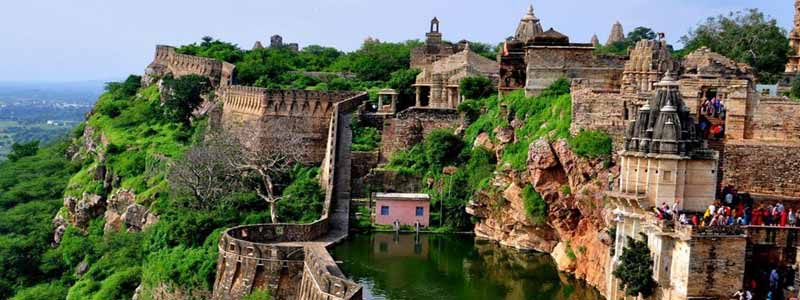
Places to Visit in Chittorgarh
Located at the southeastern nook of Rajasthan, Chittorgarh is a depository of prehistoric constructions, wealthy heritage and culture, and evergreen mythology boasting of its fine glory. The ex-kingdom of Mewar has also known for its ultimate battles especially, the blockade by Allah-Ud-Din-Khilji which is marked in the pages of history. The picturesque old city has many narrations in every wall of its highbrowed construction. The best to plan for this place is between September to March.
There are many ways to strike into beauty like by Road (hire taxi/cab, bus or own vehicle) which is connected with two main National Highways No. 76 and 79, by Airways via taking the flight for Jaipur, the state of Rajasthan which is 137 km from Chittorgarh or by Train, nearest city Ajmer’s, Railway Station is suitably connected to almost all cities. Have you gone through all the places to visit in Chittorgarh, the state of Rajasthan yet ?? If not, let’s discuss some mesmerizing places around.
Chittorgarh Fort
Chittorgarh Fort, the gigantic fort spread over 700 acres is located on the banks of the river Gambhiri and Berach in Chittorgarh, considered as the biggest fort of India and Asia. The fort was firstly built by Chitrangad Mori of the Maurya dynasty in the 7th century A.D. Later, the founder of the Mewar dynasty, Bappa Rawal made Chittorgarh his capital. This fort tops the list of tourists because of its engrossing background and the Jauhar performed by the queens of the fort during the time of combat. The foremost charm of the fort are the two steeples, Kirti Stambh (22 meters in height) and Vijay Stambh (37 meters in height).
The entry charges for adults and kids are Rs. 10 INR and Rs. 5 INR respectively. For other nationalities, the ticket price is Rs.100 INR. Apart from the fort and towers, there are many other palaces like Ratan Singh Palace, Padmini Palace, etc. and temples like Shyama Temple, Meera Temple, Sathis Deori Temple, etc. are there in this splendid premises were declared a UNESCO World Heritage Site in the year 2013. Tourists from all over the world used to visit the epic historic, Chittorgarh Fort to feel the royal, adventurous and sacrificing past of the Rajputs of Mewar Kingdom.
Padmini Palace
This castle is the palace where Rani Padmini lived after she tied the knot with the ruler of the Mewar between 1302-1303 CE, Rawal Ratan Singh. The exalted palace is the prehistoric memorial that shows the sacrifice of Rani Padmini after Chittorgarh was attacked by the Sultan Of Delhi, Allah-Ud-Din-Khilji. This two-storied monument stands right in the center of Chittorgarh Fort. The Padmini Palace is where the Rajput ladies self-sacrificed their lives when the palace was undertaken by Allah-Ud-Din-Khilji.
It resembles their faithfulness and robustness to fight or to die rather of facing disgrace. You will find it more fascinating during the visit because of the intellectuality, glamour, and charm of Rani Padmini. It is a recommended place to visit in Rajasthan for trippers. As there is no entry charge especially for Padimi Palace, you just have to pay once while entering into Vijay Stambh Chittorgarh. The timings are 8 AM-6 PM.
Fateh Prakash Palace
The Fateh Prakash Palace of Chittorgarh takes Rajput’s glory to a new altitude. The construction is luxurious, and the presentation tremendous. There are plenty of corridors and the minted display of Rajasthani paintings, there is also a huge range of glassware that shows the King’s love for it. But, now the large part of the castle is converted into Museum, open for all. The timings are at 10 o’clock in the morning from 4 o’clock in the evening, except every Friday
Kalika Mata Temple
This temple holds remarkable significance in all the tourist places of Chittorgarh. It is said to be the must-visit place if you are traveling to the city. The most attractive thing for visitors is its glorious figure. The Kalika Mata Temple is dedicated to Kalika, the epitome of Goddess Durga. This place is boasted by the building platforms of Prathira Architectural Style. All the gates, corridors, walls, and ingress have twisted designs. Some of the parts are in ruins, but one would still find grace in it as a prehistoric temple.
Sathis Deori Temple
It is the group of twenty-seven appealing temples, dedicated to the Jain Tirthankaras pinpointed in the city of Chittorgarh. Because of the group, the twenty-seven temples are also known as Sattavish Deori Temple. The beautiful temples were modeled in the 11th Century and also have a few other figurines apt to the Jain Community. You will see some old carvings and sumptuous sculptures all over them.
The Sathis Deori Temple has been declared as the World Heritage Site by UNESCO. The temple is a picture-perfect of the traditional and constructional past of Jain religion. It is not only popular in admirers but also in architecture and history freaks. The place is very peaceful and well maintained by the authority. Although photography is not allowed in the temple premises, you will be mesmerized by seeing the astonishing carvings all over the walls, pillars and stone canopies.
Geeks on the Jain Crusade Tour rabble in large numbers. If anyone wants to donate, it can be done easily for the betterment of needy and temple management. As there is no entry charge especially for Sathis Deori Temple, you just have to pay once while entering into Vijay Stambh Chittorgarh. The timings to visit 9:30 AM-6:30 PM.
Bassi Wildlife Sanctuary
Bassi Wildlife Sanctuary is situated in Chittorgarh, State of Rajasthan. It is considered as one of the foremost natural reserves of Rajasthan. It is the home for diversities of flora and fauna in and around. The sanctuary is inflated over an area of 150 sq. kilometers on the western frontier of the Vidhyanchal Mountain Ranges and many water bodies in it necessary for the herbage and brutes.
This wildlife shelter was declared as a Wildlife Sanctuary by the Government of India in 1988. You will find trees like Dhok, Churel, Butea along a variety of medicinal herbs and flowering plants. The sanctuary is an address for many animals like cheetahs and other wild cats, hyenas, wild boars, jackals, porcupines, four-horned antelopes, langurs, etc. For birdwatchers, it’s a treat to visit this place, birds like peacocks, peafowls, pigeons, saras cranes, lesser whistling duck, blue bulls, cuckoo, storks, eagles, hawks, etc. can be seen easily.




